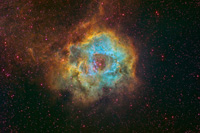As I mentioned in the
introduction,
I have only stared astrophotography. While I have taken some
astrophotos (available in the gallery) I
may not be the best source
to offer advice. As I take more images, I am sure to
get the confidence to share the good ones with you!
Below you will find:
Luckily there exists a few excellent resources for
those interested in the subject. There is my own
Advanced Topics area of the website, and there are
the following books - a must have in any aspiring astrophotographers library:
- Terrence Dickinson and Alan Dyer's The
Backyard Astronomer's Guide introduces
astrophotography and the equipment required with
a very realistic and no-nonsense method
- Michael Covington's Astrophotography for
the Amateur - Second Edition introduces a
more in-depth look at film-based
astrophotography and briefly touches on CCD
technology - while the print date of 1999 seems
outdated, the information in this book is valid
even with the use of CCD's
- Steve Howell's Handbook of CCD Astronomy
is not a user manual on how to use a CCD camera,
it goes into an in-depth look at the CCD itself
and introduces the scientific capabilities of a
CCD - read this and you will never see a CCD
camera the same way again
- Ron Wodaski's The New CCD Astronomy
is the current reigning champion of an
astrophotography how-to - very smartly written
by a down-to-Earth fellow (I had the pleasure of
opening a dialog with him) with easy to follow
instructions
In addition to his book, Ron Wodaski also has a
website and a
Yahoo Groups Forum.
And if you have a particular image you are proud
of, why not share on our gallery? Send me the image
and I'll be sure the world (or at least those who
visit the site) will see it.
Some Tips:
For film photography of the night sky, a general
rule of thumb is:
Kodak films are generally more "red"
Fuji films are generally more "blue"
So for objects like the Moon, Kodak film is quite
good and Fuji film is just as good for nebula.
Tips for SLR photography on a tripod:
- No more than a 30 second exposure (longer
than that results in star trails)
- To eliminate vibration, use the "hat trick"
- place a dark hat over the lens, open the
shutter, remove hat to expose, cover lens with
hat, close shutter
Filter Tips:
| Filter: |
Object: |
Result: |
| Blue: |
Moon |
Enhance
Surface Details |
| |
Venus |
Enhance Darker
Upper Clouds |
| |
Mars |
Enhance
Surface and Polar Caps |
| |
Jupiter |
Enhance GRS
and Light Clouds |
| |
Saturn |
Enhance Faint
Clouds |
| |
Comets |
Enhance Dust
Tail |
| Red and
Orange: |
Moon |
Enhance
Surface Details |
| |
Mercury |
Enhance
Daytime Viewing |
| |
Venus |
Reduces
Brightness in Daylight |
| |
Mars |
Enhance Yellow
Dust and Surface |
| |
Saturn |
Enhance Polar
Region and Blue Clouds |
| |
Comets |
Enhance Dust
Tail |
| Green: |
Moon |
Enhance
Surface Details |
| |
Venus |
Reduces
Daytime Brightness and Enhance Clouds |
| |
Mars |
Enhance Polar
Cap, Dust Clouds and Clouds |
| |
Jupiter |
Enhance GRS
and Blue-Red Contrast |
| |
Saturn |
Increase White
Cloud Detail |
| Yellow: |
Moon |
Enhance
Surface Details |
| |
Mars |
Enhance
Surface Dust Clouds |
| |
Jupiter |
Enhance
Orange-Red Clouds and Polar Region |
| |
Saturn |
Enhance
Orange-Red Belts |
| Violet: |
Mercury |
Helps with
Faint Detail |
| |
Venus |
Enhance Upper
Clouds |
| |
Mars |
Enhance Haze
and Clouds over Polar Cap |
| |
Saturn |
Enhance Rings |
| Deep Sky
Filter |
Deep Sky
Objects |
Reduces Sky
Haze |
| O-III
|
Diffuse Nebula |
Narrow Band -
496nm to 501 nm |
| UHC |
Diffuse Nebula |
Diffuse Nebula
- i.e. Veil Nebula |
| H-Beta |
Horsehead
Nebula |
Very Dim
Nebula Enhancement |
| |
California
Nebula |
Very Dim
Nebula Enhancement |
A Quick Word about Filters:
Filters are not a substitute for aperture, and
keep in mind that a filter - any filter - reduces
the light entering your eye. For best results with a
filter, use them for photographs. For visual use, be
sure you have very dark skies.
Good luck with your pursuit of the wonderful
hobby of Astrophotography.
Mapped Color Images:
A new trend in CCD imagery is something called a
mapped color image. All this is is replacing the
standard RGB filters with specialized scientific
filters
- Replace the Red filter with a 5nm S-II (Sulfur)
filter
- Replace the Green filter with an H-alpha
(Hydrogen) filter
- Replace the Blue filter with a O-III
(Oxygen) filter
Custom Scientific is one place to get these
filters.
Here is an example of what can be accomplished
with mapped color - images are © 2005 Russell
Croman,
www.rc-astro.com:
 |
 |
| The Rosette Nebula in RGB |
The Rosette Nebula in
Mapped |
Back to Top |

